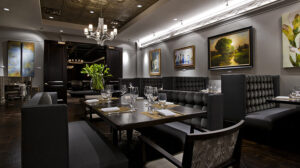 The dining room has evolved from a purely functional space into a sanctuary of style and sophistication. As we move into 2026, homeowners are discovering that achieving a luxury aesthetic doesn’t always require gutting the entire room.
The dining room has evolved from a purely functional space into a sanctuary of style and sophistication. As we move into 2026, homeowners are discovering that achieving a luxury aesthetic doesn’t always require gutting the entire room.
Strategic design choices and carefully curated elements can transform your dining space into something that rivals the most expensive renovations, all while maintaining practicality and personal charm.
The Return of Organic Textures
Natural materials are making a powerful comeback in dining room design, bringing warmth and authenticity to spaces that often feel too polished. Think reclaimed wood tables with visible grain patterns, rattan chair backs, and limestone accent walls that add depth without overwhelming the senses. These organic elements create a grounded feeling that makes luxury feel approachable rather than intimidating.
The beauty of incorporating organic textures lies in their versatility and timelessness. A solid wood dining table becomes an investment piece that develops character over time, while woven pendant shades or jute area rugs soften hard surfaces and improve acoustics. These materials work harmoniously with both minimalist and maximalist design philosophies, proving their universal appeal.
Pairing different natural materials creates visual interest without relying on bold colors or patterns. Consider combining a marble-topped sideboard with wooden dining chairs and linen upholstery. The interplay of smooth and rough, cool and warm textures elevates the sensory experience of the room, making every meal feel like an occasion worth celebrating.
Updating Dining Room Lighting
Nothing transforms a dining room quite like thoughtful lighting design, and 2026 trends emphasize layered illumination that creates ambiance and drama. Statement chandeliers remain popular, but the focus has shifted toward sculptural pieces with organic forms, oversized proportions, or unexpected materials like paper, ceramic, or blown glass. These fixtures serve as functional art pieces that anchor the room’s design narrative.
Beyond the central chandelier, incorporating multiple light sources at different heights creates depth and flexibility. Wall sconces flanking a sideboard or buffet add architectural interest while providing task lighting for serving areas. Uplighting in corners or behind plants introduces soft ambient light that makes the space feel larger and more inviting during evening gatherings.
Dimmer switches have become non-negotiable in dinning setups and dining room light fixtures, allowing you to adjust the mood from bright and energetic for family breakfasts to soft and intimate for romantic dinners. Consider installing smart lighting systems that let you create preset scenes for different occasions. The ability to control light temperature and intensity transforms a single room into multiple experiential spaces.
Moody Color Palettes
While white and neutral dining rooms have dominated for years, 2026 brings a bold embrace of deeper, more saturated color schemes. Rich jewel tones like emerald green, sapphire blue, and burgundy create cocoon-like environments that feel both intimate and opulent. These colors work particularly well in dining rooms because they enhance the convivial atmosphere of shared meals.
The key to making dark colors feel luxurious rather than cave-like is balancing them with reflective surfaces and strategic lighting. Pairing navy walls with brass hardware, crystal glassware, and a statement mirror bounces light around the room and prevents it from feeling heavy. Metallic accents in gold, brass, or bronze add warmth and glamour to moody palettes.
Don’t fear commitment when selecting bold colors for your dining room. Since this space is typically used for shorter periods compared to living areas, you can embrace more dramatic choices without risking visual fatigue. Consider extending your chosen color onto the ceiling for an enveloping effect that makes the room feel intentionally designed rather than accidentally dark.
Artisan-Crafted Details
Mass-produced furnishings are being replaced by handcrafted pieces that tell stories and showcase human skill. Whether it’s hand-thrown ceramic dinnerware, a custom-built dining table by a local woodworker, or chairs upholstered in fabric from independent textile artists, these artisan elements add soul and distinction to dining spaces. They represent a rejection of disposable design culture in favor of lasting quality.
Investing in artisan pieces doesn’t mean furnishing the entire room with custom items. Strategic placement of one or two handcrafted elements among more accessible pieces creates an elevated aesthetic without breaking the budget. A handwoven table runner or hand-painted serving platter can transform the entire tablescape, making even simple meals feel special.
The beauty of artisan details extends beyond aesthetics into sustainability and ethical consumption. Supporting independent makers means investing in pieces made with care, quality materials, and fair labor practices. This conscious approach to design aligns with broader luxury values that prioritize authenticity, longevity, and meaningful consumption over fleeting trends.
Flexible Dining Configurations
Modern life demands versatility, and 2026 dining rooms reflect this with adaptable layouts that serve multiple functions. Extendable tables that accommodate intimate dinners or large gatherings, modular seating arrangements, and furniture on casters that can be repositioned easily make the dining room work harder. This flexibility is the ultimate luxury in homes where space comes at a premium.
Creating zones within the dining room adds functionality without sacrificing style. A bar cart or beverage station in one corner, a small desk area for homework or laptop work in another, transforms the room from single-use to multi-purpose. These designated areas maintain the room’s primary dining function while acknowledging how people actually live and use their homes.
The Finishing Touch
Transforming your dining room into a space that feels professionally renovated comes down to thoughtful curation rather than expensive overhauls.
By embracing organic materials, sculptural furniture, sophisticated lighting, bold colors, artisan craftsmanship, and flexible layouts, you create a room that reflects both current design sensibilities and timeless luxury principles.


